
I’ve put together this detailed guide laying out all the most important information on e-bike batteries for the layperson to understand.
Understanding e-bike batteries can be confusing without a background in electronics. Knowing what Watts, Amps, and Volts are, and how they affect your e-bikes performance, and future e-bike purchase decisions can be confusing for a beginner. There’s also the battery chemistry to consider, and the various battery mounting locations on the e-bike’s frame to consider.
Table of Contents
Which type of battery is best for an electric bike?
Lithium e-bike batteries are the only real choice of battery nowadays, offering a good combination of price, weight and performance. The technology is getting better and cheaper with every passing year- a process known as the lithium-ion ‘learning curve’.
A decade or more so ago, there was an argument to be made that lead-acid batteries, like those found in cars as starter batteries would make sense on a bike. This argument is no more, as the cost of lithium-ion batteries has fallen dramatically and the energy density of lead-acid batteries has not really improved since then.
Most electric bike kit providers that you will find online will only use lithium ion batteries- with good reason. It’s better to follow their lead.
Electric Bike Battery Types

There are a multitude of considerations when choosing either a new e-bike or when choosing a kit to purchase, including on a removable or non-removable battery, and where the battery should be positioned on the bike.
Removable versus Non-Removable Batteries
When purchasing a new e-bike, deciding on a removable or non-removable battery (also known as an integrated battery) is one of the first considerations to decide on.
| Pros | Cons | |
| Removable Battery | + More convenience for charging and long term storage + Can be easily removed for on-street parking + Can usually be replaced by the user when the battery reaches the end of it’s usable life | + For some, the bulky looking battery on the frame is off putting |
| Non-removable (integrated) battery | + Aesthetics- creates a sleek, stealthy look, disguising an e-bike as a regular bike | + The e-bike must be moved to where the charger is located + User swapping the battery is more complicated + Battery storage with a non-removable battery is more restrictive |
Personally, I would only purchase a removable battery as it’s more flexible, convenient, and easier to replace when needed as the battery ages.
Battery Positions – Frame Battery
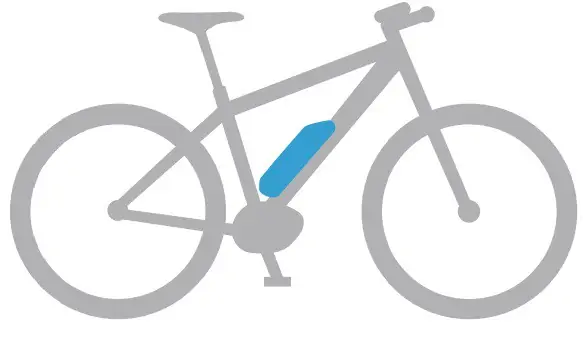
Frame batteries are probably the most common battery configuration for many types of e-bike, with good reason. It’s a sensible, flexible configuration, suited to many types of e-bikes – road bikes, commuter bikes and mountain bikes. The position of the battery on the angled down tube means it sits low, close to the e-bike’s center of gravity. This helps with handling and ensures superb weight distribution.
Recommended for: I personally own a frame battery e-bike, and I wholeheartedly recommend them for most riders.
Battery Positions – Rack Battery

Rack e-bike batteries are convenient and comfortable. For those who wish to purchase a step through e-bike – particularly for ladies looking for an e-bike or seniors with mobility difficulties- a rack mounted battery offers the ideal way to get on and off the e-bike easily and safely.
The main downside of a rack mounted battery configuration is that it’s positioned higher on the e-bike than other battery configurations, meaning that the handling isn’t optimal. However, for casual riding and commuting, this is not a major concern.
Recommended for: casual commuters, ladies who want a step through bike, seniors with mobility issues
Battery Positions – Integrated Battery
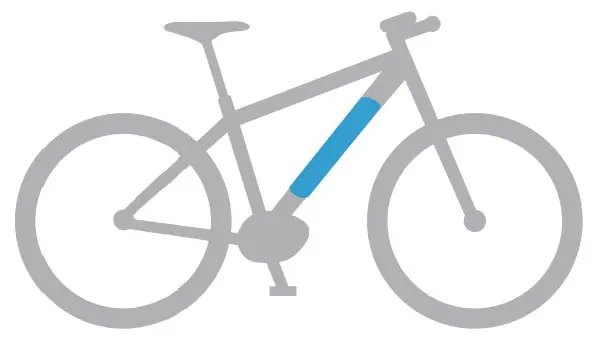
Non-removable batteries, also known as integrated batteries, are popular on some commuter e-bikes. The battery is usually integrated into the design of the e-bike by the manufacturer, this is not a type of battery configuration that is possible with an e-bike kit.
Integrated batteries offer a sleek, stealthy look – for the casual observer, it’s difficult to distinguish this type of e-bike from a regular bike!
There are some downsides to the type of e-bike – less flexible charging options, less flexible storage options, more complex battery replacements – but if aesthetics is the major priority for you, this is the type of e-bike to get.
Recommended for: those who wish to have a sleek aesthetic above all else.
Battery Positions – Dual Batteries

For those looking for unparalleled battery range on their e-bike, a dual battery configuration is the way to go. This type of battery configuration is found on high end e-bikes, such as some Riese and Muller e-bikes. The main types of e-bikes with dual batteries are long-distance touring bikes, high-end mountain bikes, and some heavy duty cargo bikes.
Recommended for: those who wish to have the maximum range, for extreme commutes, for long-distance touring e-bikes, or for intense mountain biking on challenging trails.
Can I use car battery for an e-bike?
No, you shouldn’t use a car battery for your e-bike project. While it’s technically possible to use a car battery on an e-bike, lithium batteries will give you more range and capacity, for less weight compared to a typical lead-acid car battery. Additionally, car batteries are bulky and unwieldy, and will not fit well in the frame of your bike.
Have a look below at the comparison in energy densities between the two battery technologies.
| Lithium Ion | Lead Acid | |
| Energy Density | 125-600+ Wh/L | 50-90 Wh/L |
What does this table mean? It means that a lithium-ion battery, compared to a lead-acid battery of identical size, gets up to 12 times the range before it needs to be charged! In other words, a lithium-ion battery takes up less space and weight and frees up space in the electric bike frame to keep the bulkiness of the battery as low as possible.
How long does an electric bike battery last?
You can expect a typical lithium-ion battery to last between 2 to 4 years with typical usage.
The actual lifetime of the battery will depend on factors like how many discharge cycles- full 0-100% charges/discharges are done, the temperature – cold weather discharges the battery more quickly, how hilly the areas that you ride in are, if you store your battery in optimal conditions, and more.
Can I put a bigger battery on my e-bike?
Yes, it’s generally possible to insert or fit a bigger battery onto your e-bike or even retrofit a regular bike to an electric bike.
However, it’s important to understand the trade-offs and considerations- namely, the cost of the battery upgrade, the increase in weight– which can make the bike more difficult to ride, and decrease the e-bike’s portability. This last point is especially important to consider if you are regularly navigating your e-bike through cramped hallways to park it inside, or especially if you have to move it up and down a flight of stairs.
Generally, it’s a good idea to size your battery to the expected typical journey rather than overspending on a larger battery that you don’t normally use completely. When the battery reaches the end of life after a few years of usage, you can benefit from lower prices to get a replacement.
So let’s say your commute is 30km (about 18.7 miles) round trip. If your battery can do a little more than that, you’re set. If you can charge at work, even better, you can stretch the range even more.
E-Bike Battery Replacement
When your e-bike’s range starts to diminish, you’ll know that it’s time to start looking for a replacement battery.
When it comes time to replace your battery, you have several options to consider. The best choice for you will come down to your budget, how much time you want to spend searching for a replacement battery, and your level of expertise with lithium battery technology and comfort with DIY’ing solutions.
Easiest option- get a replacement from the original battery manufacturer
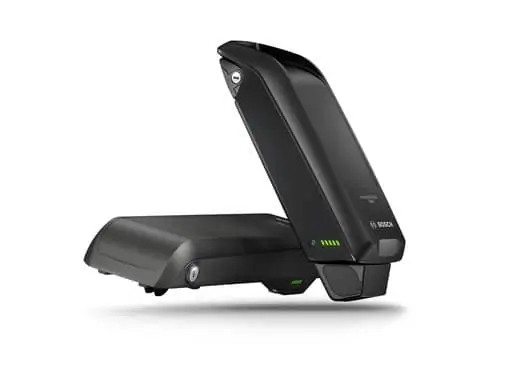
| Budget Required | Time Needed | Expertise Needed |
| ★★★ | ★ | ★ |
Getting an identical battery pack from the original manufacturer (also known as an OEM) is the most straightforward way of replacing your electric bike battery. You are guaranteed to get an original, reliable part that is designed to work perfectly with your exact e-bike model.
To order a replacement, either contact the manufacturer directly or the retailer you purchased the bike from and ask about the options for ordering. The manufacturer may allow direct orders from the factory, or may direct you to a retailer than can help you. If you purchased the e-bike new from a retailer, contact them instead and ask about a replacement battery for your e-bike model.
Get an original replacement battery from a third-party
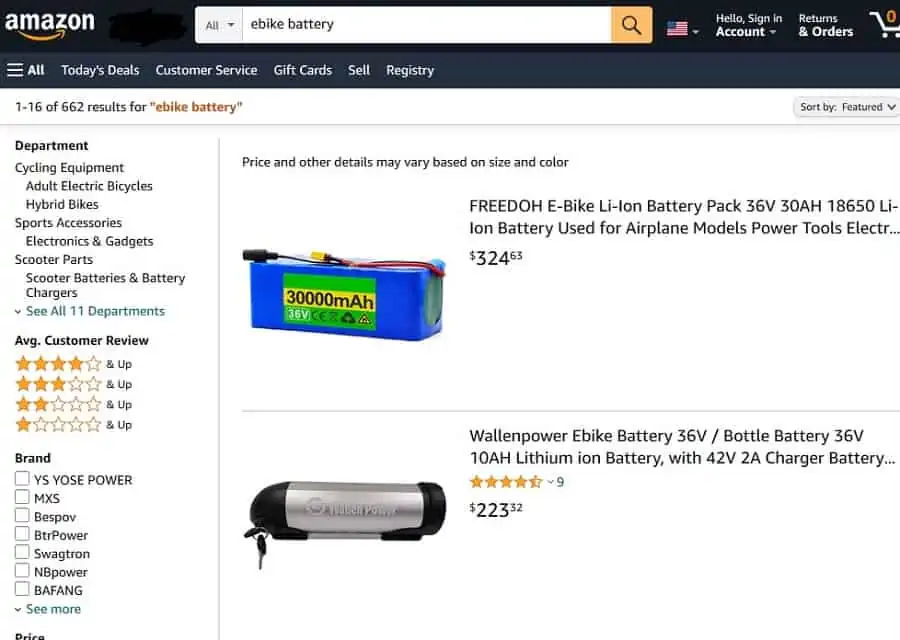
| Budget Required | Time Needed | Expertise Needed |
| ★★ | ★★ | ★★ |
Purchasing an original part from a third-party, like on eBay or Amazon, is a way to save money (sometimes) compared to buying the battery from official sources. It’s akin to sourcing a replacement car part yourself to avoid the large markup of a service center that sources the part on your behalf.
For this, you will need the part number of the battery and use it to start looking online. If you find a good deal, great! Inserting the new battery is often as simple as snapping the new battery into the slot on the bike frame – at least for e-bikes with removable batteries. If you’ve got an e-bike with a non-removable battery, you should contact the manufacturer for instructions on how to replace the battery or consult the user manual.
Fabricating a replacement battery pack
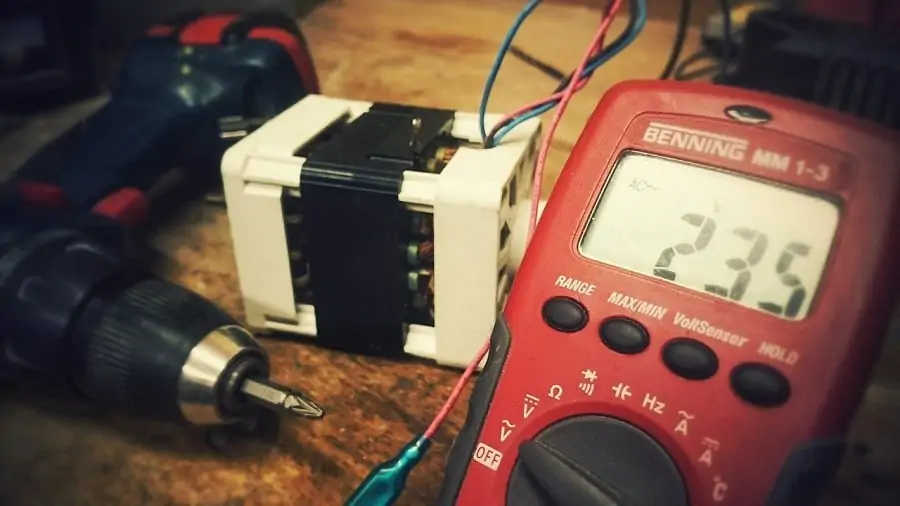
| Budget Required | Time Needed | Expertise Needed |
| ★★ | ★★★ | ★★★ |
If the company that you originally ordered your e-bike from is no longer in business, or the battery part is no longer available or you have decent knowledge of lithium batteries, it’s possible to replace your e-bike battery with a DIY battery pack that you fabricate yourself.
Keep in mind that using non-approved parts will void your warranty, and that you are likely to damage your e-bike if you don’t carefully check exactly what parts that you’re ordering.
You’ll most likely need some specialized tools like a lab bench power supply and a spot welder, unless you can borrow these tools for your project.
Creating your own battery pack requires some in-depth knowledge of electronics too. Messing about with a battery pack is not a good idea unless you really know what you’re doing- there’s the risk of electrocution or damaging your expensive electric bike.
Since I do not yet have experience with an advanced project like this, I will leave you with some excellent videos I’ve come across on the topic. Where is a two part video series below. The first video is more of a general project introduction- why you might want to consider doing this and some of the parts involved in creating such a project.
The second video here dives into more detail on the battery pack aspect.
He does a great job of explaining the relationships between the electrical terms (Volts, Amps etc – more on those below) with some wonderful hand drawn illustrations that can give you a nice starting point for attempting such a project for yourself. He also dives into the process of researching the battery cells that you might consider using for a DIY e-bike battery pack. He covers testing the cells with the lab bench power supply, spot welding the individual battery cells together into the larger battery pack, and how to setup a Battery Management System (BMS) which is vital to keep your battery pack healthy- to ensure that the cells do not over-charge or over-discharge themselves.
Electric Bike Battery Terminology Explained
Understanding Volts, Amps and Watts can be confusing for those unfamiliar with electrical terms. I’ve laid out everything in simple terms and related it to e-bikes so it makes sense- and hopefully leaves you informed, not confused!
In general, the larger the number of Volts, Amps, Amp hours, Watts or Watt hours = the greater the performance.
Volts Explained – Should I Overvolt?
Volts are how fast the electrons actually move. It’s also referred to as electric pressure. As far as e-bike are concerned, more volts = more speed! This is also true for electric motors on e-scooters. Think of Volts as being the “horsepower” of your e-bike.
Higher Volts increase torque and acceleration.
The symbol for volts when reading spec sheets is “V”.
Some e-bike enthusiasts like to “overvolt” the motor to squeeze more speed out of the e-bike, but this is for experts only and will void your warranty.
When looking at batteries and motors, common Voltages are 36V, 48V, 52V, 60V, and even up to 72V sizes. 36V is good for casual cruising, while 72V will have you eating up the tarmac.
A higher battery pack voltage will give you more efficiency. You can draw less amps for the same amount of watts with more volts. The battery cells themselves resist current flow. This resistance appears in the form of heat.
Here’s a handy video explaining how to check the voltage on an e-bike battery using a multi-meter.
You may no be wondering how you can apply the knowledge in this video above. Here is a very handy chart that illustrates the charge percentage and voltage amount for some common sizes of battery packs- 36V, 48V, 52V, 60V and 72V, so you can determine the percentage that your battery is charged:
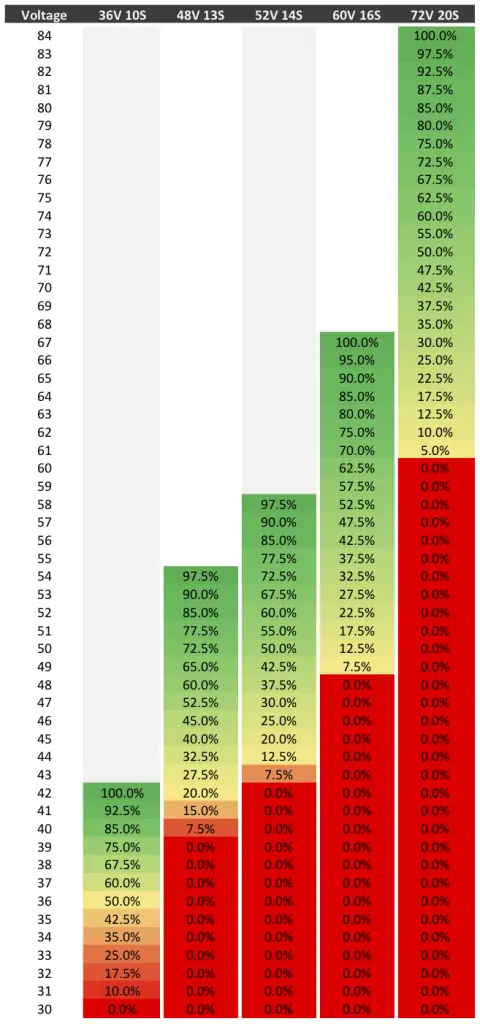
Amps Explained
Amps are a measure of how many electrons flow pass a point in a given second. It’s a measure of force.
Amps are like how wide a pipe is- a wider pipe allows more water to flow per second. Higher Amps for an e-bike require thicker wires and larger, more powerful battery packs.
The combination of Volts and Amps equals Watts.
Amp Hours Explained – Is a higher Ah battery better?

Amp hours are a simple way of estimating battery life.
Amp hours are a measure of electric charge, measured over a period of time, or the “potential charge capacity” of your battery. Think of Amp Hours (Ah) as the gas tank of your electric bike, which determines the range of your e-bike. The larger the Ah, the longer you’ll be able to use the pedal assist.
When deciding on a battery purchase, the size of your battery depends on your needs. Buying an oversized battery may not make much sense if you don’t normally need it for your typical use. Deciding on a battery should be based on your normal distance that you ride, how aggressively you want to ride, the weight you typically carry (cargo and rider!), how hilly the area is and the climate where you live (colder weather saps lithium batteries more quickly than temperate climates.)
Watts Explained – Are Higher Watt Motors Better?
Watts are the overall measure of the potential power than can be used or generated. Think of Watts as like the “engine size” of your electric bike, determining the maximum power output, like a 1.4 liter engine or a 2.0 liter engine.
Higher Watts increase the overall power of the engine, which is helpful for pulling heavy loads and climbing hills.
Common motor Watt sizes are 250W, 500W, 750W and even 1000W and beyond- 2000W and 3000W motors and above are available, but are unnecessary for most common e-bike uses.
250W is common in some parts of the world, and is the legal limit in much of Europe for regular Pedelec e-bikes. For my uses, which is casual weekend fun and commuting at a moderate pace, this is plenty. A 250W motor will more than double the power output of the average rider versus pedaling alone.
If you’re looking to zip up hills or carry larger loads or haul a large e-bike trailer, a larger motor up to 1000W in power are for you.
Watt Hours explained – the most important E-Bike battery metric

Watt hours are the amount of continuous Watts that a battery can draw for an hour.
A 500Wh battery can deliver 500W for one hour. That same 500Wh battery can deliver 250W for 2 hours, and 1000W for half and hour.
Watt hours (Wh) is the most common measurement of a battery’s usable capacity that you’ll see on most e-bike comparison websites. A higher number means more range, and usually is more expensive than a battery with less Wh.
See the table in the next section below for an illustration of the relationship between Watt hours, load and run time.
Watt hours are the most important battery metric to look out for on an e-bike’s spec sheet, to help you choose the right e-bike for your budget.
How to Calculate an E-bike’s Battery Run Time or Capacity
| Battery Capacity in Watt Hours (Wh) | Load (from e-bike motor) | Run time (Hours) |
| 250Wh | 250W | 1 hour |
| 250Wh | 500W | 0.5 hours |
| 250Wh | 1000W | 0.25 hours |
| 500Wh | 250W | 2 hours |
| 500Wh | 500W | 1 hour |
| 500Wh | 1000W | 0.5 hours |
| 1000Wh | 250W | 4 hours |
| 1000Wh | 500W | 2 hours |
| 1000Wh | 1000W | 1 hour |
As you can see from this table, if you are considering a higher power 1000W motor, you need to consider a high capacity battery or your available run time on electric power or electric assist will be very brief indeed. As mentioned above, you can get a dual battery configuration as a premium option. This will enable you to achieve higher Watt-hours like 1000Wh+ mentioned in this table.
As you can already imagine, riding an e-bike on throttle assist only (no pedal assist) will draw more power versus pedal assist. Therefore, how aggressively you use the pedal assist has a major impact on the distance you can travel with the electric motor before the battery is drained.
Common Electric Bike Battery Sizes
- 36V battery – the smallest commonly seen electric bike battery size
- 48V battery
- 52V battery
- 72V battery – the largest commonly seen battery size. This is the choice if you are selecting a 1000W+ monster-sized e-bike motor!
How and When to Charge your E-Bike Battery
- Charging your e-bike battery overnight is ok, but not optimal
- Tips for charging your e-bike at home
- Tips for charging your e-bike at work
Charging e-bike battery first time
It may take up to 12 hours to charge your e-bike battery for the first time. Leave the battery plugged in until the charge indicator is fully lit up (the charge indicator is a lit series of bars indicating the charge level, present on many e-bike battery packs). A longer first charge conditions the battery to ensure that all the cells are fully operational from the start. Further information on charging for the first time.
How to Extend your E-Bike Battery Range and Lifespan
There are actions that you can take when charging or storing your battery to significantly extend its useful lifespan, saving you money and saving waste going into a landfill.
Battery Storage and Charging Tips
Even the best-maintained lithium battery will slowly lose capacity even when well maintained. Following these tips will extend your battery’s useful lifespan, however.
- Store the battery in a cool place (e.g. a cellar, shed, or a north-facing room), at room temperature, at around 50% charge level– between 32F to 68F (0-20 degrees Celsius). Storing lithium batteries between 30-70% charge significantly improves battery longevity, in other words, battery degradation is minimal in this range. Link to scientific analysis on battery degradation.
- Charging the battery up to just 80% of its total capacity almost doubles the lifespan. If you can avoid charging and discharging that last 20%, you will significantly extend your battery’s lifespan.
- After riding your e-bike, wait at least 30 minutes before charging. It’s better to charge a battery that is at room temperature, rather than one that is very warm (i.e. just after being used). Another way to avoid charging a warm battery is to charge it the evening before you need it.
- Storing the battery at 100% charge in warm weather significantly reduces longevity (particularly keeping it plugged in, this keeps the battery at peak voltage). Above 105’F/40’C is considered warm – think of inside a car on a hot day or in direct sunlight in a desert climate
- Lots of time spent at high voltage is bad for lithium cells. Don’t charge the battery to 100% and leave it for days or weeks, use it a little, then charge it
- Avoid ultra-fast chargers, these weaken your battery
- More tips on when to charge your battery
- Excellent article on how to prolong your batteries (applies to all lithium batteries)
- Professor Jeff Dahn, of Dalhousie University (foremost expert on Lithium-ion batteries) on what causes Lithium-ion batteries to die:
How to Extend your Batteries Range when Riding
- Go easy on the throttle on a Pedelec. You’ll get more exercise this way too!
- Coast downhill sections or approaching a red light without pedal assist
- If you’re not in a hurry to work, ride at a leisurely pace
- Keep your chain and gears well oiled
- When cycling on a flat road, keep your tires well inflated. For mountain bikes, don’t overinflate– 0.9 – 1.3 bar is recommended for plus-size tires. A bit of slack helps your wheel over the bumps.
- Go through your backpack and carrying basket – discard what you don’t need for this bike ride. Avoid bringing your work laptop home with you if it’s not needed!
- Keep a smooth, circular motion to your pedal strokes. Driving sharply down increases your battery consumption as the pedal sensor has to ‘guess’ how much assistance you require
- If you’re traveling a particularly long distance regularly, carry a spare battery in a backpack, or consider buying a dual battery e-bike.
